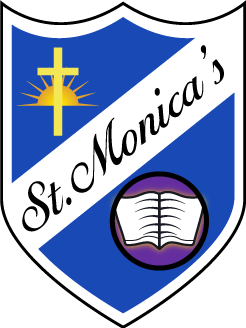Science
Science at St. Monica's
'To promote curiosity about the world and how it works, through child-centred activities.'
At St Monica’s Catholic Primary School, we believe a high-quality science education provides the foundations for understanding the world. Science has changed, and continues to change our lives and all pupils should be taught essential aspects of the knowledge, methods, processes and uses of science.
Between Year 1 and Year 6, we teach Science using the CUSP curriculum, which pays close attention to guidance provided by the National Curriculum sequence and content. Our ambitious Science curriculum has the intention of increasing children’s ability to think scientifically, enriching children’s vocabulary and wider view of the world, and putting what they learn into practice.
At St Monica's we aim to provide a rich experience of Science that enables our children to experience both depth and breadth in the units they cover. This is achieved through our “revisit” units where we revise units from earlier parts of the year to consolidate learning.
The methodology for teaching Science at St Monica's is to provide opportunities for children to develop their questioning skills, ignite curiosity and to widen their knowledge of the world and how it works. We want our children to respond proactively and positively to problem solving challenges and strive to learn more about the “how” and “why” of the world around us and beyond. We recognise that ‘our children are the future’ and they need to be equipped with the necessary skills to take risks, become resourceful, innovative, and questioning in order to become capable citizens.
We also recognise that Science encompasses a broad range of subject knowledge and draws on disciplines from the wider world such as mathematics, engineering, computing and geography. We believe making these curriculum connections are essential components that help to engage and connect our children with the opportunities Science provide.

We have a clear focus on Disciplinary and Substantive Knowledge in our lessons:
Substantive knowledge– this is the subject knowledge and explicit vocabulary used to learn about the content. Common misconceptions are explicitly revealed as non-examples and positioned against known and accurate content. In CUSP science, an extensive and connected knowledge base is constructed so that pupils can use these foundations and integrate it with what they already know. Misconceptions are challenged carefully and in the context of the substantive and disciplinary knowledge. In CUSP Science, it is recommended that misconceptions are not introduced too early, as pupils need to construct a mental model in which to position that new knowledge.
Disciplinary knowledge – this is knowing how to collect, use, interpret, understand and evaluate the evidence from scientific processes. This is taught. It is not assumed that pupils will acquire these skills by luck or hope. Pupils construct understanding by applying substantive knowledge to questioning and planning, observing, performing a range of tests, accurately measuring, comparing through identifying and classifying, using observations and gathering data to help answer questions, explaining and reporting, predicting, concluding, improving, and seeking patterns. We call it ‘Working Scientifically.’

What is CUSP and how does it inspire our Intent, Implementation and Impact in Science?
INTENT
A guiding principle of CUSP Science is that each study draws upon prior learning. For example, in the EYFS, pupils may learn about The Natural World through daily activities and exploring their locality and immediate environment. This is revisited and positioned so that new and potentially abstract content in Year 1, such as "Animals, including Humans", is related to what children already know. This makes it easier to cognitively process. This helps to accelerate new learning as children integrate prior understanding.
CUSP Science is organised into three distinct subject domains: biology, physics and chemistry.

IMPLEMENTATION
CUSP Science has sequenced the national curriculum into meaningful and connected ‘chunks’ of content to reduce the load on the working memory as well as creating coherent and strong long-term memories. The sequence of substantive and disciplinary knowledge enables pupils to become ‘more expert’ with each study and grow an ever broadening and coherent mental model of the subject. This guards against superficial, disconnected and fragmented scientific knowledge and weak disciplinary knowledge. Each learning module in CUSP Science has a vocabulary module with teacher guidance, tasks and resources to enhance and deepen understanding.
CUSP Science is planned so that the retention of knowledge is much more than just ‘in the moment knowledge’. The cumulative nature of the curriculum is made memorable by the implementation of retrieval and spaced retrieval practice, word building and deliberate practice tasks. This powerful interrelationship between structure and research-led practice is designed to increase substantive knowledge and accelerate learning within and between study modules.
New content is connected to prior learning. The effect of this cumulative model supports opportunities for children to associate and connect significant scientific concepts, over time, and with increasing expertise and knowledge.
CUSP Science deliberately pays attention and values the importance of subject content as well as the context it is taught in. Common scientific misconceptions are identified in all CUSP Science learning modules. These misconceptions are made explicit to pupils. Children draw upon substantive and disciplinary knowledge to reason and practise acquiring the conception, whilst repelling the misconceptions.
CUSP Science values the study of scientists from the past as well as promoting diverse present-day role models in the field. These studies help us to learn how they used, at that time, their substantive and disciplinary knowledge to develop a conception.
IMPACT
CUSP fulfils and goes well beyond the expectations of the National Curriculum. By following this curriculum, we hope children will know more, remember more, understand more about the curriculum.
All children will have:
- A wider variety of skills linked to both substantive and disciplinary knowledge
- A richer vocabulary which will enable them to articulate their understanding of taught concepts
- Confidence and a love of learning for all things science
